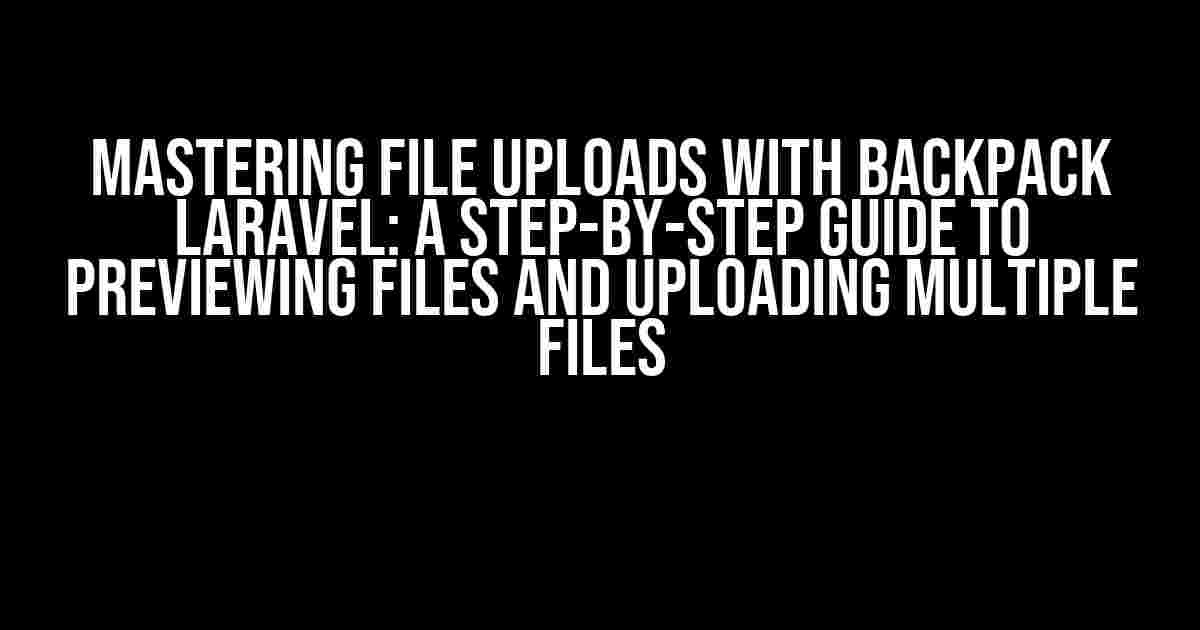Backpack Laravel is an incredible admin package that simplifies the process of building admin panels for Laravel applications. One of the most essential features of any admin panel is file uploads. In this article, we’ll dive into the world of Backpack Laravel and explore how to preview files and upload multiple files with ease. Buckle up, and let’s get started!
Why Do We Need to Preview Files?
Previewing files before uploading them is crucial for several reasons:
- Validate user input: Previewing files allows you to validate user input and ensure that the uploaded files meet the required criteria, such as file type, size, and resolution.
- Enhance user experience: By providing a preview of the uploaded file, you can give users an opportunity to review and correct any mistakes before submitting the form.
- Reduce server load: Previewing files on the client-side can reduce the load on your server, as you can validate and process files before uploading them.
Setting Up Backpack Laravel for File Uploads
Before we dive into the world of file uploads, make sure you have Backpack Laravel installed and set up in your Laravel application. If you haven’t, follow the official installation guide.
Step 1: Create a New CRUD Controller
Let’s create a new CRUD (Create, Read, Update, Delete) controller for our file upload functionality. Run the following command in your terminal:
php artisan backpack:crud File FileController
This command will generate a new CRUD controller, model, and views for our file upload functionality.
Step 2: Configure the File Upload Field
In the `FileController` , add a new field for file uploads in the `setUp` method:
<?php
namespace App\Http\Controllers\Admin;
use Backpack\CRUD\app\Resources\File;
class FileController extends Controller
{
public function setup()
{
// ...
$this->crud->addField([ // File uploader
'name' => 'attachment',
'label' => 'Attachment',
'type' => 'file',
'upload' => true,
'wrapper' => [
'class' => 'form-group col-md-12',
],
]);
}
}
In this example, we’ve added a new field called `attachment` with a label `Attachment`. We’ve set the `type` to `file`, and `upload` to `true` to enable file uploads.
Previewing Files with JavaScript
To preview files before uploading them, we’ll use JavaScript to read the file contents and display a preview. We’ll use the `FileReader` API to read the file contents and generate a preview.
Step 1: Add a Preview Container
In your `file.blade.php` view, add a container to display the file preview:
<div class="form-group">
<label>Attachment</label>
<input type="file" name="attachment" id="attachment">
<div id="attachment-preview"></div>
</div>
In this example, we’ve added a `div` with an ID `attachment-preview` to display the file preview.
Step 2: Add JavaScript Code
Add the following JavaScript code to your `file.blade.php` view:
<script>
const attachmentInput = document.getElementById('attachment');
const attachmentPreview = document.getElementById('attachment-preview');
attachmentInput.addEventListener('change', (e) => {
const file = attachmentInput.files[0];
const reader = new FileReader();
reader.onload = (event) => {
const preview = `<img src="${event.target.result}" alt="${file.name}">`;
attachmentPreview.innerHTML = preview;
};
reader.readAsDataURL(file);
});
</script>
In this code, we’ve added an event listener to the `attachment` input field. When the file input changes, we read the file contents using the `FileReader` API and generate a preview image. We then display the preview in the `attachment-preview` container.
Uploading Multiple Files
Uploading multiple files with Backpack Laravel is a breeze. We’ll modify the `attachment` field to accept multiple files and update the JavaScript code to preview multiple files.
Step 1: Update the Attachment Field
In the `FileController` , update the `attachment` field to accept multiple files:
<?php
namespace App\Http\Controllers\Admin;
use Backpack\CRUD\app\Resources\File;
class FileController extends Controller
{
public function setup()
{
// ...
$this->crud->addField([ // File uploader
'name' => 'attachments',
'label' => 'Attachments',
'type' => 'file_multiple',
'upload' => true,
'wrapper' => [
'class' => 'form-group col-md-12',
],
]);
}
}
In this example, we’ve updated the `attachment` field to `attachments` and set the `type` to `file_multiple` to accept multiple files.
Step 2: Update the JavaScript Code
Update the JavaScript code to preview multiple files:
<script>
const attachmentsInput = document.getElementById('attachments');
const attachmentsPreview = document.getElementById('attachments-preview');
attachmentsInput.addEventListener('change', (e) => {
const files = attachmentsInput.files;
const previews = [];
Array.prototype.forEach.call(files, (file) => {
const reader = new FileReader();
reader.onload = (event) => {
const preview = `<img src="${event.target.result}" alt="${file.name}">`;
previews.push(preview);
attachmentsPreview.innerHTML = previews.join('');
};
reader.readAsDataURL(file);
});
});
</script>
In this updated code, we’ve modified the JavaScript code to iterate over the multiple files and generate a preview for each file. We then display the previews in the `attachments-preview` container.
Conclusion
In this article, we’ve explored how to preview files and upload multiple files using Backpack Laravel. By following these steps, you can enhance the user experience and simplify the file upload process in your Laravel application. Remember to always validate user input and ensure that the uploaded files meet the required criteria.
Troubleshooting Tips
- Verify file uploads: Make sure that the `upload` attribute is set to `true` in the `attachment` field.
- Check file types: Ensure that the uploaded file types are allowed in your application.
- Debug JavaScript code: Use the browser’s developer tools to debug any JavaScript errors.
By following these tips and the instructions outlined in this article, you should be able to successfully preview files and upload multiple files using Backpack Laravel.
| Keyword | Description |
|---|---|
| Backpack Laravel | A popular admin package for Laravel applications |
| File uploads | The process of uploading files to a server |
| File preview | A preview of the uploaded file displayed to the user |
| Multiple file uploads | The ability to upload multiple files at once |
By mastering file uploads with Backpack Laravel, you can create robust and user-friendly admin panels for your Laravel applications. Happy coding!
Frequently Asked Question
Get ready to unravel the mysteries of Backpack Laravel and master the art of previewing files and uploading multiple files like a pro!
How do I preview files in Backpack Laravel?
To preview files in Backpack Laravel, you can use the `preview` method provided by the `Backpack\NewsCRUD\app\Http\Controllers\FileController`. This method returns a JSON response with the file’s contents, which can then be used to generate a preview. You can also use third-party libraries like `league/flysystem` to achieve this.
How do I upload multiple files at once in Backpack Laravel?
To upload multiple files at once in Backpack Laravel, you can use the `uploadMultiple` method provided by the `Backpack\NewsCRUD\app\Http\Controllers\FileController`. This method allows you to upload multiple files in a single request, and returns an array of uploaded file information. You can also use JavaScript libraries like `Dropzone.js` to make the upload process more user-friendly.
How do I validate file uploads in Backpack Laravel?
To validate file uploads in Backpack Laravel, you can use the `validate` method provided by the `Illuminate\Http\Request` object. You can specify validation rules for the uploaded files, such as `mimes`, `max`, and `required`, to ensure that only valid files are uploaded. You can also use custom validation rules to fit your specific use case.
How do I store uploaded files in a specific folder in Backpack Laravel?
To store uploaded files in a specific folder in Backpack Laravel, you can use the `store` method provided by the `Illuminate\Http\Request` object. You can specify the folder where the files should be stored, and Laravel will take care of the rest. You can also use the `storage` facade to interact with the file system and store files in a custom location.
Can I customize the file upload process in Backpack Laravel?
Yes, you can customize the file upload process in Backpack Laravel to fit your specific use case. You can create custom request handlers, validation rules, and file storage logic to meet your requirements. You can also extend the built-in file upload features of Backpack Laravel to add custom functionality.


